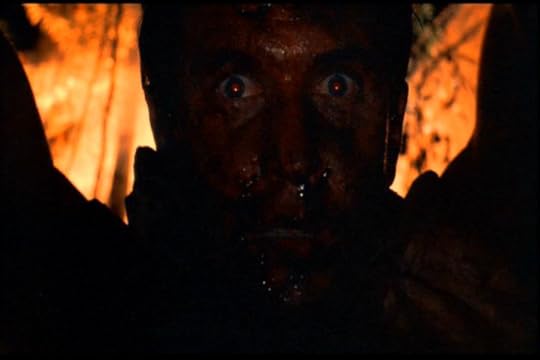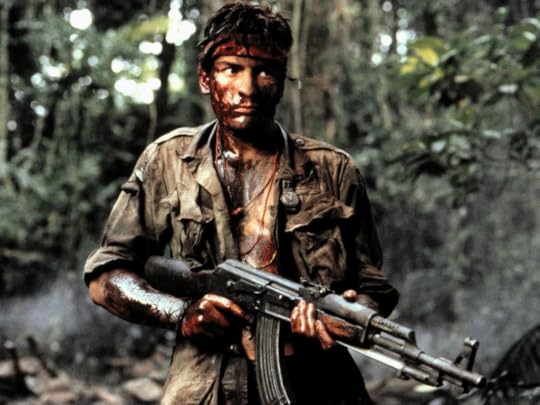DT Moviehouse Review: Platoon
Time once more for my blog feature, DT Moviehouse Reviews, in which I make my way alphabetically through my DVD/Blu-Ray collection (you can see the list right here) and decide if each one was worth the money. Today, I review Oliver Stone’s Platoon.

Screenplay by: Oliver Stone
Directed by: Oliver Stone
Tagline: The First Casualty Of War Is Innocence
What’s It About?
The loyalties of new recruit Chris Taylor (Charlie Sheen) and his fellow grunts are tested in a civil war between humanistic Sergeant Elias (Willem Dafoe) and sadistic Staff Sergeant Barnes (Tom Berenger) in a forward operating rifle company along the Cambodian border during the Vietnam War.

Why I Bought It:
The best war films are of course anti-war films and this is one of the most literate and affecting war films ever made. All credit to Oliver Stone’s script (based on his own experiences) and determined vision because it really comes across as the greatest anti-war novel about Vietnam never written, McCarthy-esque in its beautiful brutality and the primal, universality of its themes and characters.
It’s realized by an absolutely superb cast, a mix of knowns, unknowns, and soon-to-be knowns. I was struck on a recent viewing at how much each man’s very face and physicality seems to perfectly align with the father figure they end up clinging to. Lerner (Johnny Depp), Francis (Living Colour front man Corey Glover), Big Harold (Forrest Whittaker), King (Keith David), et al seem to exude innocence or fraternal empathy, whereas Barnes’ loyalists Bunny (Kevin Dillon), O’Neil (John C. McGinley), Junior (Reggie Johnson), Ace (Terry McIlvain) etc. (no aspersions on the actors) seem to emanate menace or plain ‘assholery.’

Willem Dafoe is one of the best actors working today, equally capable of delivering as an almost reptillian, terrifying villain and also as a source of empathy. His Elias (even his name bespeaks holiness) is a beacon of light among the mud, flies, and elephant grass. You almost never see him with his helmet on, always with this angelic shock of wavy hair. Not a conventionally handsome man, he’s beautiful in this, to the extent of flirting with homoeroticism. There are several moments where Elias seems to smile flirtaciously at the other guys, and least one where baby-faced Lerner appears to walk up to him while he’s either urinating or masturbating on the edge of camp. He also has Taylor put the muzzle of a shotgun into his mouth while he blows marijuana smoke through the breach, almost like a kiss. Stone somehow accentuates the dime blueness of his eyes, and he issues orders with the gentleness of a kindly father. When his outrage is kindled during the village scene, it’s like the righteousness of a previously mild mannered Christ overturning the moneylenders’ tables – surprising. It’s amusing that in one scene one of the soldiers says “Three years in and he thinks he’s Jesus fuckin’ Christ” and Barnes refers to him as a ‘water walker’ when two years later he will literally play Jesus to the nines in Scorcese’s Last Temptation of Christ (maybe Marty got the idea watching him in this).

Contrast him to Tom Berenger’s scarred and disapproving Barnes, whose every drawling declaration is a threat of violence. He’s almost never seen without his helmet and gear, and it gives him a machine like quality. The only time we see him smile, a full toothed grin, is on the verge of the climactic attack. He smiles openly at the terrified Lt. Wolf (Mark Moses) as if in anticipation of the carnage to come. In the midst of it, when in his berserk fury he nearly brains Taylor with an entrenching tool, the napalm fires of the roaring slicks overhead light up his flaring irises and he embodies the very face of war and madness.
Both men are the magnetic poles of the movie, wrenching Taylor between civilized empathy and barbaric sadism. When one of their sentries is found with his throat cut and the platoon descends upon a hapless village gnashing their teeth for revenge, Taylor, in his narration, calls Barnes their Ahab and relates “That day we loved him.” Then when he seizes a wailing nine year old girl and jams a pistol into her temple, Taylor and the rest of Elias’ squad falter in their support. After the murder of Elias, the ‘Heads,’ led by Taylor, whip themselves into a lather to frag Barnes, only to have him cow them singlehandedly.

Berenger and Dafoe convey as much with their eyes as with their dialogue. When two soldiers are killed by a booby trap, Taylor glances into the ruin and sees Barnes sitting pensively, stroking his scar and apparently grieving the loss. This silent emoting is particularly well done in the scene where Barnes finds Elias alone in the bush and shoots him. Elias, having just cut through and routed a company of NVA singlehandedly, tenses up at the sight of Barnes, then slips into an easy, friendly smile, like a man strolling in the woods who finds a friend. Elias is so good natured he’s even happy to see Barnes, whom he has just reported to the dai uy (Capt. Dale Dye) for the village massacre. Barnes’ eyes soften for just a second before he decides to silence his rival, and Dafoe’s eyes in turn falter a second too late. It’s masterfully played out.

The lynchpin of the movie is Sheen’s performance as Taylor, impressionable and swayed, the “son of two fathers.” He’s The Kid in the Blood Meridian analogy. He effectively portrays the weathering of Taylor from an idealistic and naïve college dropout to a hardened combat veteran. It’s interesting to consider the movie was shot in the Phillipines the same as Apocalypse Now, Coppola’s Vietnam epic which starred his father Martin Sheen ten years previously. Charlie Sheen apparently visited the set of Apocalypse and (according to a documentary Brothers In Arms, about the making of Platoon, directed by Paul Sanchez, who played Doc) apparently swore he would never return.

Every member of the cast gives believable and memorable performances, to a man. You can probably quote even the minor characters’ lines and immediately recall their faces. Dillon is chilling as the psychopathic Bunny, Johnson is great as the shiftless and mutinous Junior, and McGinley is a particular standout as Barnes’ toadie Sgt. O’Neil. Keith David’s King is wonderful as a kind of big brother to Taylor. He’s too good to be caught up in the hell of the climactic firefight and catches a bird home. Dale Dye, ubiquitous military advisor on numerous films after his contribution to Platoon, is memorable as the CO. Oliver Stone himself makes an appearance as an officer who gets blown up in his staff bunker by a sapper late in the movie.
As I mentioned, I watched the companion doc Brothers In Arms by Paul Sanchez, which mainly focuses on the rigorous two week military training period advisor Dale Dye put the cast through. This seems to be standard practice for military movies now, putting the cast through a boot camp, but I don’t know how prevalent it was in the 80’s. Dye’s innovative contribution definitely had a lasting impact on the cast (the doc is definitely worth a watch). Not just their comportment in terms of combat maneuvering and marching, but their hangdog faces and thousand yard stares, particularly in the memorable tracking shot of the platoon when they discover the body of Manny really carry an authenticity that I can’t recall from many other pictures. The camaraderie of these guys is really palpable. I love the scene when the ‘Heads’ are in their bunker drunk and high and dancing to Tracks of My Tears. The cut to Barnes’ straight edge guys playing poker and listening to Merle Haggard in their own bunker, decrying the potheads as they sip Kentucky windage is an amusing contrast.
One thing the doc made me aware of which I had never really considered in previous viewings, was the low budget-ness of the film. This was a 6 million dollar picture, when by comparison, another 1986 movie Stone wrote, 8 Million Ways To Die, had a budget of 18 million dollars. The cast didn’t have amenities and trailers, it was very much a shoestring production. The movie is basically a lot of actors running around in the jungle. Very few set pieces. They do an immense lot with comparatively little.
I’ve also got to mention Samuel Barber’s soaring Adaggio For Strings. It was previously used in David Lynch’s The Elephant Man, but for me, it’s indelibly linked to the imagery from Platoon.
There is a particularly beautiful shot of the ambush marching out into the jungle at night while King sonorously sings Oh Susanna and lightning crackles down behind them. I don’t know if it’s real or an effect but it looks great. It reminded me of a similar shot in John Ford’s She Wore A Yellow Ribbon. God’s blessing if it wasn’t added in post.


Best Dialogue/Line:
TAYLOR: I think now, looking back, we did not fight the enemy; we fought ourselves. And the enemy was in us. The war is over for me now, but it will always be there, the rest of my days as I’m sure Elias will be, fighting with Barnes for what Rhah called possession of my soul. There are times since, I’ve felt like the child born of those two fathers. But, be that as it may, those of us who did make it have an obligation to build again, to teach to others what we know, and to try with what’s left of our lives to find a goodness and a meaning to this life.
Best Scene:
It has to be Elias’ demise.
Barnes has informed Taylor that he found Elias’ body out in the jungle and they have to evacuate on the choppers before their position is overrun by NVA and the oncoming artillery pounds the LZ. Taylor reluctantly boards the Huey and as they rise above the ruined church he gives a shout and points.
Set to the heartrending strains of Adaggio For Strings, Elias comes running out of the jungle with the NVA battalion behind him, lighting him up with machinegun fire, shells exploding all around.

The gunships attempt to cover his escape but the LZ is too hot to regain and as the whirling shadows of the Hueys pass over the scene like immense dragonflies and depart, Elias raises his arms up, beseeching, catches a final bullet in the back, and collapses.
Taylor, emboldened, glares at Barnes and for the first time, doesn’t look away.
The shot of Dafoe kneeling in anguish, with his arms outthrust to heaven like an enraptured supplicant is iconic. In that image he seems to embody the bedraggled Vietnam infantryman damned for his deeds, begging forgiveness of God or understanding or pity from all of us.
It’s a beautiful, beautiful scene.

Would I Buy It Again? Definitely. This is the finest war film ever made.
Next In The Queue? TBD



